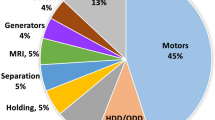Abstract
The behavior that different magnetic treatment directions induce various amounts of welding residual stress reductions in low alloy steel was studied. Reductions of 26%–28% in the longitudinal stress σ x were obtained when low frequency alternating magnetic treatment was applied perpendicularly to the welding bead, whereas reductions of 20%–21% in σ x were measured by using the same treatment parameters except that the field direction was applied parallel to the bead. It is proposed that different extent of stress reductions caused by the above two treatment directions is attributed primarily to the alteration of the energy absorbed by domains from the external magnetic field, which part of energy can arouse plastic deformation in microstructures by the motion of domain walls.
Similar content being viewed by others
References
R F Hochman, N Tselesin, V Dris. Magnetic Fields: Fertile Ground for Metals Processing [J]. Advanced Materials & Processes, 1998, 8: 36–41
P C Miller. Look at Magnetic Treatment of Tools and Wear Surface [J]. Tooling & Production, 1990, 55(12): 100–103
D Paulmier. Steel Surface Modifications in Magnetised Sliding Contact [J]. Surface and Coating Technology, 1995, 76-77: 583–588
J Bockstedt, B E Klamecki. Effects of Pulsed Magnetic Field on Thrust Bearing Washer Hardness[J]. Wear, 2007, 262: 1086–1096
S N Prasad, P N Singh, V Singh. Influence of Pulsating Magnetic Field on Softening Behavior of Cold Rolled AISI4340 Steel at Room Temperature[J]. Scripta Materialia, 1996, 34(12): 1857–1860
F D Snegovskij, V A Uvarov. The Influence of Magnetic Treatment of Screw Propeller on the Cavitation Wear[J]. Trenie. I Iznos, 1991, May–Jan: 535-539
M S C Bose. Effect of Saturated Magnetic Field on Fatigue Life of Carbon Steel[J]. Physica Status Solidi (A), 1984, 86: 649–654
A Celik, A F Yetim, A Alsaran, M Karakan. Effect of Magnetic Treatment on Fatigue life of AISI 4140 Steel[J]. Materials and Design, 2005 26: 700–704
B E Klamecki. Residual Stress Reduction by Pulsed Magnetic Treatment [J]. Journal of Materials Processing Technology, 2003, 141(3): 385–394
F Tang, A L Lu, J F Mei, H Z Fang, X J Luo. Research on Residual Stress Reduction by a Low Frequency Alternating Magnetic Field [J]. Journal of Materials Processing Technology, 1998, 74: 255–258
F Tang. Research on Residual Stress Reduction in Steel by Pulsed Magnetic Treatment [D]. Beijing Department of Mechanical Engineering, Tsinghua University, 1999
Z P Cai, J A Lin, L A Zhou, H Y Zhao. Evaluation of Effect of Magnetostriction on Residual Stress Relief by Pulsed Magnetic Treatment [J]. Materials Science and Technology, 2004, 20(12): 1563–1566
S Wu, H Y Zhao, A L Lu, H Z Fang. Micro Mechanism of Reducing Residual Stress by Low Frequency Alternating Magnetic Treatment [J]. Transactions of the China Welding Institution, 2002, 23(1): 10–11
Z P Cai, H Y Zhao, J A Lin, A L Lu. Plastic Deformation Caused by Pulsed Magnetic Treatment of Mid-carbon Steel [J]. Materials Science Engineering A, 2007, 458: 262–267.
W D Zhong. Ferromagnetics (volume 2) [M]. Beijing: Science Press, 1987(in Chinese)
R C O’Handley. Modern Magnetic Materials: Principles and Applications [M]. Wiley Interscience, New York, 1999
Author information
Authors and Affiliations
Corresponding author
Additional information
Funded by the Teaching and Research Award Program for Outstanding Young Teachers in Higher Education Institutions of Ministry of Education, China (No. [2002] 383), Science and Technology Planning Project of Wuhan City, China (No. 20067003111-05)
Rights and permissions
About this article
Cite this article
Song, Y., Hua, L. & Wang, B. Reduction of residual stress in low alloy steel with magnetic treatment in different directions. J. Wuhan Univ. Technol.-Mat. Sci. Edit. 24, 857–862 (2009). https://doi.org/10.1007/s11595-009-6857-8
Received:
Accepted:
Published:
Issue Date:
DOI: https://doi.org/10.1007/s11595-009-6857-8




